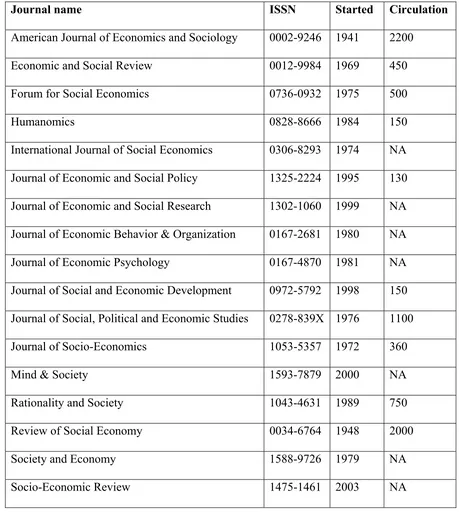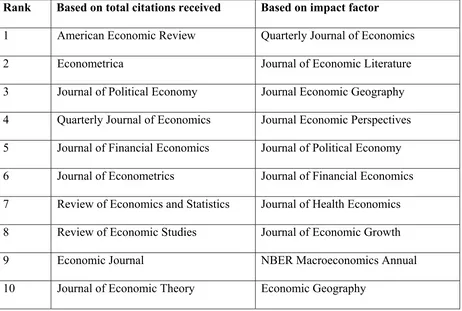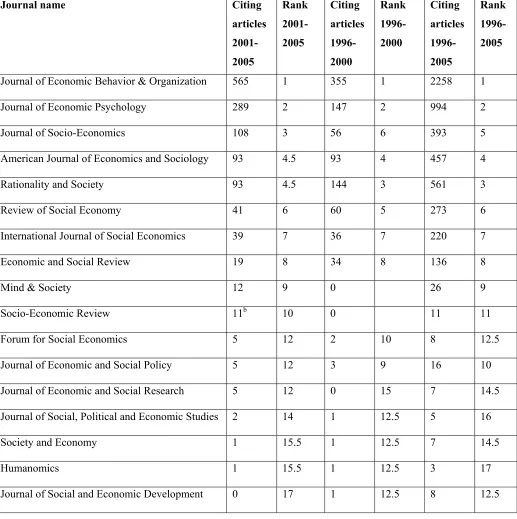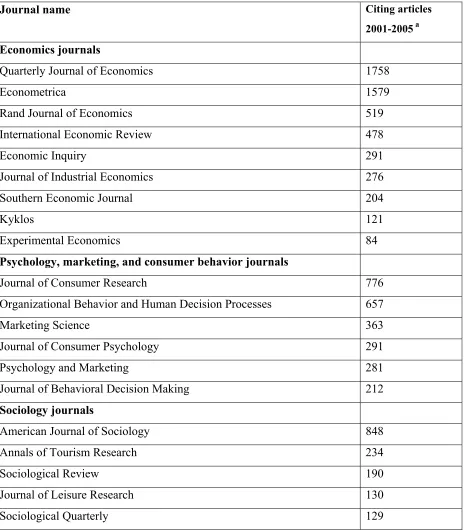Munich Personal RePEc Archive
Behavioral economics and
socio-economics journals: A
citation-based ranking
Azar, Ofer H.
Ben-Gurion University of the Negev
2006
This is a pre-print working paper version (before the review process), of the article Azar, Ofer H. (2007), "Behavioral Economics and Socio-Economics Journals: A
Citation-Based Ranking," Journal of Socio-Economics, 36(3), 451-462.
The final version of this article (that is significantly different from this version) is available at http://dx.doi.org/10.1016/j.socec.2006.11.001.
Behavioral Economics and Socio-Economics Journals:
A Citation-Based Ranking
Ofer H. Azar
*Department of Business Administration
Guilford Glazer School of Business and Management
Ben-Gurion University of the Negev, Israel
Journal quality is a major consideration for authors, readers, and promotion and tenure committees, among others. Unfortunately, most behavioral economics and socio-economics journals are not included in published rankings or in Journal Citation Reports. Consequently, no objective ranking of these journals exists. To address this need, a list of journals in behavioral economics and socio-economics was compiled, and the number of articles that cited each journal was recorded for the periods 2001-2005, 1996-2000, and 1996-2005. In all periods Journal of Economic Behavior & Organization was ranked first and Journal of Economic Psychology second. In 2001-2005 Journal of Socio-Economics ranked third.
Keywords: Journal rankings; Citation analysis; Behavioral economics; Socio-economics; Economics and psychology
JEL classification codes: A14, A12, A10, B50, Z10, Y80
*
Ofer H. Azar, Department of Business Administration, School of Management, Ben-Gurion University of the
Negev, P.O.B. 653, Beer Sheva 84105, Israel. Tel.: +972-8-6472675; Fax: +972-8-6477691. E-mail address:
1. Introduction
One of the fundamental working hypotheses in academia is that there is a strong positive
correlation between the quality of an article and the quality of the journal in which it is
published. Indeed, a journal attains high quality and reputation by publishing good articles,
leading to this positive correlation. As a result, knowing the quality of the journal is of great
importance to many people in academia: authors want to know this in order to choose smartly
to which journals to submit their papers; readers want to know the journal's quality in order to
decide which articles deserve careful reading; and promotion and tenure committees, as well
as funding agencies and people who write reference letters, need to know the journal's quality
in order to assess correctly the qualifications of a candidate for promotion, tenure, or a grant.
Journal quality is also the basis for many rankings of universities and departments – in order
to estimate the academic value of each publication generated by the department's faculty, for
example, the quality of the journal in which the article was published has to be taken into
account (see for example Coupe, 2003 and Lubrano et al., 2003).
The most common way to assess the quality of journals is based on the number of
citations they receive.1 When an article is cited, it generally suggests that it contributed
significantly to the literature on which the citing article builds, and so the number of citations
that an article receives is a commonly-used indication of its quality. When we add up the
number of citations that all the articles published by a certain journal received, we obtain a
measure of journal quality.
1
Sometimes further manipulations are used, such as giving different weights to different citing journals, or
The importance of citations in indicating journal quality led to the creation of various
databases that record citations in academic journals. ISI Web of Knowledge (henceforth ISI)
and its "Web of Science" database, for example, include Science Citation Index Expanded,
Social Sciences Citation Index, and Arts & Humanities Citation Index. These databases track
continuously thousands of journals in various disciplines and record all the citations that
appeared in them. Based on these databases, ISI also publishes its "Journal Citation Reports"
(henceforth JCR) that report the total number of citations that a journal received in a given
year from all other journals in the database, as well as some additional measures of journal
performance.
The great importance of assessing the relative quality of journals resulted in various
rankings of academic journals. In economics, for example, some prominent examples include
the rankings by Liebowitz and Palmer (1984), Laband and Piette (1994), and Kalaitzidakis et
al. (2003). Additional economics journal rankings include Barrett et al. (2000), who created
rankings by sub-discipline (according to JEL codes)2, the perception-based ranking by
Axarloglou and Theoharakis (2003), and the ranking based on citations in textbooks by Liner
(2002).
In principle, one can learn from a general ranking also about the relative position of
journals in a certain sub-field. In practice, however, these general rankings often do not
include enough of the sub-field journals to provide meaningful information for people
interested in that specific sub-field. As a result, rankings of journals in a specific sub-field are
sometimes published to address this need, for example the agricultural economics ranking by
2
They ranked the journals that contributed the most to each JEL letter category (e.g., code L is industrial
organization). Unfortunately, no letter corresponds to behavioral economics or socio-economics, so their
Burton and Phimister (1996), the applied econometrics ranking by Baltagi (1999), and the
international business ranking by Dubois and Reeb (2000).
Unfortunately, in behavioral economics and socio-economics the vast majority of journals
are not included in published rankings of economics journals or in the JCR data, and yet no
journal ranking for these fields was published yet. Consequently, there is no objective
measure of journal quality for most journals in these fields. This article attempts to address
this lack by providing such a ranking.
Behavioral economics encompasses these areas that are related to both economics and
psychology, for example the effect of psychological motivations on economic decision
making and consequently also on firms and markets. Socio-economics includes areas that are
related to both economics and sociology, for example the influence of social norms on
economic behavior. It makes sense to include both behavioral economics and
socio-economics journals in the same ranking because the overlap between these two fields is large.
The effect of social norms on economic behavior, for example, is often related also to
psychological motivations and to social psychology. This large overlap between behavioral
economics and socio-economics is also reflected in the relevant journals, with many journals
publishing research in both areas.
2. Methodology
The first step in creating a ranking of behavioral economics and socio-economics journals
is to decide which journals belong to this group. To do so, the databases of ISI and Ulrich's
Periodicals Directory (henceforth UPD) were searched, and journals that satisfied the
conditions of being active, refereed, academic / scholarly, published more than once a year,
and in English, were considered. The journal descriptions in UPD, the information provided
were used in order to determine which journals focus on behavioral economics and/or
socio-economics and should therefore be included in the ranking. Table 1 presents the journals
selected and some information about them (based on UPD data).
In order to rank the journals, the database of ISI was used. This database tracks only a
selection of journals, which does not include most of the journals listed in Table 1.
Fortunately, however, ISI database is nevertheless useful, because it records all citations from
the indexed journals, even when the cited journal is not an indexed journal. This allows to use
ISI database to obtain citation information even for journals that ISI does not index. It should
be emphasized that the citations recorded in this database are therefore not all the citations
that a certain article received, but those that came from journals indexed by ISI.
Rankings of academic journals often follow one of two alternative methodologies. One is
to compute the total number of citations the journal received, and the second is to compute a
per-article measure of citations by dividing the total number of citations by the number of
articles in the journal (this is often called an "impact factor"). Here I follow the first
methodology, for two reasons.
First, the goal here is to evaluate the importance of journals and their contribution to
research in behavioral economics and socio-economics. It is clear that a journal that publishes
100 articles each year and generates 1000 citations is much more influential and important,
and contributes more to research in the field, than a journal that publishes 20 articles each
year and generates 200 citations, even though the impact factor is identical for both journals.
Second, when we compare rankings obtained using the two alternative measures, it
becomes clear that the first methodology produces more reasonable results. For example,
Table 2 presents the top 10 journals in JCR economics for 2004 based on either the total
the ranking based on total citations reflects the most important and respected journals in
economics much better than the ranking based on the impact factor.
Because most of the journals listed in Table 1 are not indexed by ISI, we cannot use JCR
to obtain information on the number of times they were cited. It is possible, however, to get a
closely related measure of citations using manual searches in the ISI database and filtering
the results.3 What we can obtain this way is the number of different articles that cited a
certain journal in a certain time period. This method was employed over a recent time period
(2001-2005), an earlier period (1996-2000), and a combined period (1996-2005). The period
2001-2005 gives the most updated information and best represents the current quality of the
listed journals, especially given that several journals started during the period 1996-2000. The
period 1996-2000, however, allows to examine which journals moved up or down over the
last decade, and how stable is the ranking over time. The combined period gives information
that is based on a longer period and therefore reflects the quality of the journals over a longer
time period.
3. Results
Table 3 presents the rankings obtained from the methodology explained above in the
three periods. The results show that the Journal of Economic Behavior & Organization is by
3
ISI uses various shorthands to record the names of journals, and not always in a consistent manner for journals
that are not indexed. For example, the Journal of Socio-Economics appears as J SOCIOECONOMICS, J SOCIO
EC, J SOCIOECON, and in a few cases even in other forms. Therefore, in order to get all the citations to a
journal, one needs to search for all possible ways it could be indexed and to use wildcards in the search for this
purpose, and then go over the results one by one to make sure no other journals are included (for example,
searching for the Journal of Socio-Economics using "J socio*ec*" also gives results like J SOCIO EC DEV,
far the most-cited journal, for any of the three periods. The second place goes in all periods to
the Journal of Economic Psychology. The third place goes in 2001-2005 to the Journal of
Socio-Economics, which made a big jump up from 1996-2000 to 2001-2005.4 The journal
that occupied the third place in 1996-2000 but lost this position to be ranked 4.5 in
2001-2005 is Rationality and Society. Other than the Journal of Socio-Economics and Rationality
and Society, no other journal in the top 8 journals moved more than one rank between the two
periods.
In order to be able to compare the performance of the journals in the list not just among
themselves but also to journals in other disciplines, the number of citing articles for the
period 2001-2005 was computed also for several journals from other disciplines that might be
of interest to those who work in the fields of behavioral economics and socio-economics,
such as economics, psychology, marketing, consumer behavior, and sociology. It should be
noted, however, that one should take into account that some disciplines tend to cite more than
others. For example, if we take the total number of citations received by all journals in a
discipline in 2004 and divide it by the number of articles published in that discipline, we get
19.8 in economics, 20.4 in sociology, 24.1 in applied psychology, and 25.4 in business. When
comparing between disciplines these differences should be considered. An applied
psychology journal that was cited in 300 articles, for example, might in fact be in a lower
relative ranking (in the applied psychology field) compared to the relative ranking in
economics of an economics journal that was cited in 270 articles.
4
Two main changes can help explain this big jump in JSE ranking: in 2002 the editor of the JSE and much of
the editorial board changed, and at around the same time Elsevier purchased the journal – and big publishers
such as Elsevier often make journals more easily accessible, thus helping to disseminate the journal's articles,
4. Conclusion
This article reports for the first time a ranking of journals in the fields of behavioral
economics and socio-economics. This is an important endeavor because it gives valuable
information to people who want to evaluate the quality of different journals in this area, such
as authors, readers, and members of promotion and tenure committees.
References
Axarloglou, K., Theoharakis, V., 2003. Diversity in economics: An analysis of journal
quality perceptions. Journal of the European Economic Association 1, 1402-1423.
Baltagi, B., 1999. Applied econometrics rankings: 1989–1995. Journal of Applied
Econometrics 14, 423-441.
Burton, M., Phimister, E., 1996. The ranking of agricultural economics journals. Journal of
Agricultural Economics 47, 109-114
Barrett, C.B., Olia, A., Bailey, D.V., 2000. Subdiscipline-specific journal rankings: whither
Applied Economics? Applied Economics 32, 239-252.
Coupe, T., 2003. Revealed performances: world wide rankings of economists and economic
departments: 1990–2000. Journal of the European Economic Association 1, 1309-1345.
Dubois, F.L., Reeb, D., 2000. Ranking the International Business Journals. Journal of
International Business Studies 31, 689-704.
ISI Web of Knowledge: Web of Science and Journal Citation Reports databases, available
online at http://portal.isiknowledge.com/
Kalaitzidakis, P., Mamuneas, T., Stengos, T., 2003. Rankings of academic journals and
institutions in economics. Journal of the European Economic Association 1, 1346-1366.
Laband, D., Piette, M., 1994. The relative impact of economics journals. Journal of Economic
Liebowitz, S.J., Palmer, J.P., 1984. Assessing the relative impacts of economic journals.
Journal of Economic Literature 22, 77-88.
Liner, G.H., 2002. Core journals in economics. Economic Inquiry 40, 138-145.
Lubrano, M., Bauwens, L., Kirman, A., Protopopescu, C., 2003. Ranking European economic
departments: A statistical approach. Journal of the European Economic Association 1,
1367-1401.
Table 1: Journal Information
Journal name ISSN Started Circulation
American Journal of Economics and Sociology 0002-9246 1941 2200
Economic and Social Review 0012-9984 1969 450
Forum for Social Economics 0736-0932 1975 500
Humanomics 0828-8666 1984 150
International Journal of Social Economics 0306-8293 1974 NA
Journal of Economic and Social Policy 1325-2224 1995 130
Journal of Economic and Social Research 1302-1060 1999 NA
Journal of Economic Behavior & Organization 0167-2681 1980 NA
Journal of Economic Psychology 0167-4870 1981 NA
Journal of Social and Economic Development 0972-5792 1998 150
Journal of Social, Political and Economic Studies 0278-839X 1976 1100
Journal of Socio-Economics 1053-5357 1972 360
Mind & Society 1593-7879 2000 NA
Rationality and Society 1043-4631 1989 750
Review of Social Economy 0034-6764 1948 2000
Society and Economy 1588-9726 1979 NA
Table 2: Top 10 Economics Journals in JCR 2004
Rank Based on total citations received Based on impact factor
1 American Economic Review Quarterly Journal of Economics
2 Econometrica Journal of Economic Literature
3 Journal of Political Economy Journal Economic Geography
4 Quarterly Journal of Economics Journal Economic Perspectives
5 Journal of Financial Economics Journal of Political Economy
6 Journal of Econometrics Journal of Financial Economics
7 Review of Economics and Statistics Journal of Health Economics
8 Review of Economic Studies Journal of Economic Growth
9 Economic Journal NBER Macroeconomics Annual
Table 3: Rankings of Behavioral Economics and Socio-Economics Journals a
Journal name Citing
articles 2001-2005 Rank 2001-2005 Citing articles 1996-2000 Rank 1996-2000 Citing articles 1996-2005 Rank 1996-2005
Journal of Economic Behavior & Organization 565 1 355 1 2258 1
Journal of Economic Psychology 289 2 147 2 994 2
Journal of Socio-Economics 108 3 56 6 393 5
American Journal of Economics and Sociology 93 4.5 93 4 457 4
Rationality and Society 93 4.5 144 3 561 3
Review of Social Economy 41 6 60 5 273 6
International Journal of Social Economics 39 7 36 7 220 7
Economic and Social Review 19 8 34 8 136 8
Mind & Society 12 9 0 26 9
Socio-Economic Review 11b 10 0 11 11
Forum for Social Economics 5 12 2 10 8 12.5
Journal of Economic and Social Policy 5 12 3 9 16 10
Journal of Economic and Social Research 5 12 0 15 7 14.5
Journal of Social, Political and Economic Studies 2 14 1 12.5 5 16
Society and Economy 1 15.5 1 12.5 7 14.5
Humanomics 1 15.5 1 12.5 3 17
Journal of Social and Economic Development 0 17 1 12.5 8 12.5
The numbers in the "Citing articles" columns denote the number of articles that cited the
journal in that period. For example, the number 565 in the column 2001-2005 corresponding
appeared in journals indexed by ISI cited during the period 2001-2005 articles that appeared
in JEBO during the same period.
a
The reader should be careful when interpreting the results for journals that did not exist for
the entire period; these include Mind & Society (started in 2000), Socio-Economic Review
(started in 2003), Journal of Economic and Social Research (started in 1999), and Journal of
Social and Economic Development (started in 1998).
b
It is possible to get a better approximation for the relative quality of Socio-Economic
Review in the 2001-2005 period in the following way. The journal started to be published in
2003, so the articles that cited it all come from the period 2003-2005. A few additional
searches in the database reveal that 350 articles cited Journal of Economic Behavior and
Organization, Journal of Economic Psychology, and Journal of Socio-Economics during
2003-2005, compared with 964 articles that cited these journals during the period 2001-2005
(the reason the number for 2001-2005 is much higher is that articles from 2001-2002 have
more time to be cited than articles published in 2003-2005 when we consider citations from
the period 2001-2005). We can apply the ratio 964/350 = 2.75 to obtain that Socio-Economic
Review achievement of 11 citations in 2003-2005 is roughly equivalent to 30 = 2.75*11
Table 4: A Comparison to Journals in Other Fields
Journal name Citing articles
2001-2005 a
Economics journals
Quarterly Journal of Economics 1758
Econometrica 1579
Rand Journal of Economics 519
International Economic Review 478
Economic Inquiry 291
Journal of Industrial Economics 276
Southern Economic Journal 204
Kyklos 121
Experimental Economics 84
Psychology, marketing, and consumer behavior journals
Journal of Consumer Research 776
Organizational Behavior and Human Decision Processes 657
Marketing Science 363
Journal of Consumer Psychology 291
Psychology and Marketing 281
Journal of Behavioral Decision Making 212
Sociology journals
American Journal of Sociology 848
Annals of Tourism Research 234
Sociological Review 190
Journal of Leisure Research 130
Sociological Quarterly 129
a



